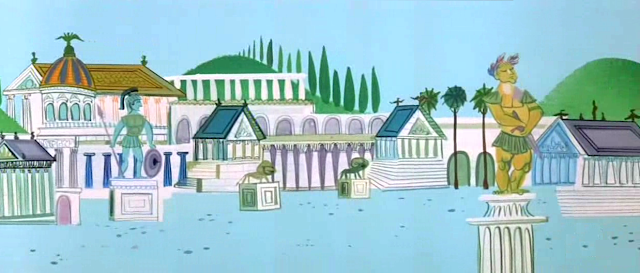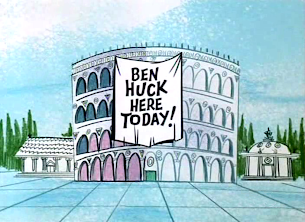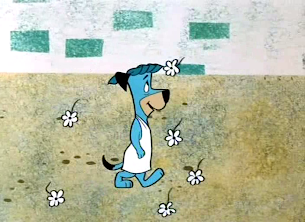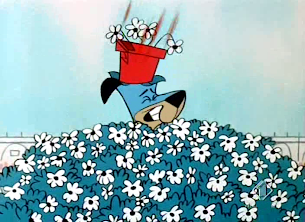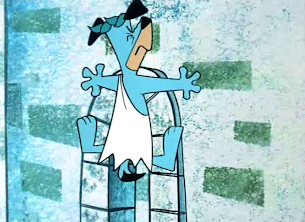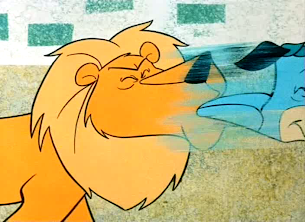Occasionally, an unexpected name pops up in the credits of Hanna-Barbera cartoons around 1960. Clarke Mallery, Phil Duncan and Gil Turner come to mind. Turner, for example, was at UPA and Format Films around the same time. You might wonder whether he had trouble holding a job but that may not have been the case at all.
Variety of June 7, 1960 had a lengthy article on a lack of animators in Hollywood. Hanna-Barbera was humming with two syndicated half-hour shows on the air (Huckleberry Hound and Quick Draw McGraw) and had “The Flintstones” in production for a fall debut on ABC. Al Brodax had subcontracted for a pile of new made-for-TV Popeye cartoons. Limited animated versions of Dick Tracy and Mr Magoo were on the small screen. Larry Harmon was making Bozo cartoons. And some portions of Jay Ward’s beloved “Rocky and His Friends” were being drawn in the U.S. There were only so many animators to go around and it appears some were working at more than one studio simultaneously. That may explain some of the more unexpected animator credits.
Here’s the story from Variety. It was, more or less, reprinted in the weekly edition from New York eight days later.
Shortage Of Animators Due To Videmand,
Producers Ask Art Inst. To Teach The Art
A far-reaching program of “laying down a vintage of talent” for the animation film industry has been underway locally with “at least” 15 independent animation film producers sponsoring the plan to ease the shortage of trained help.
According to producers Jay Ward and Bill Scott of Ward Productions, “there are only about 1,000 persons trained in the field, and the industry could use at least 2,500 right now.” In some cases, it has necessitated producers going out of the country, notably to Japan and Mexico to have their work done.
“The issue is so critical,” declared Herb Klynn of Format Films, “we have grouped together and are meeting Thursday night with the Chouinard Art Institute in an effort to have a four-year course set up which will somewhat ease the shortage in the foreseeable future. At the rate of progress this phase of the industry is growing, we can now only barely meet our 1961 commitments and will certainly not be able to expand our programming unless we ‘rob’ talent from each other.”
At the moment, it is known that considerable “moonlighting” is going on, with talent working at one studio during the day and performing for others at night. Television spot commercials have increased the demand but it is in area of the half-hour animated cartoons that the shortage is most seriously felt.
“Cartooning is an essential part of television programming,” said Scott, and a successful cartoon series is “worth $7 million dollars.”
As more talented people entered the field, it became obvious the need for knowledge in the basic crafts was known by but a few, and there has not yet been found a training ground for those who wish to enter the industry. Jay Ward Productions, planning a one-hour special for this fall, will combine live and cartoon talent in “The Magic of Christmas.” However, since the company is already committed to three other shows, it has found it necessary to use animators and artists in Mexico.
“This has proved unsatisfactory,” Ward stated, “due to the language barrier. We can’t seem to communicate our exact feelings of satire to them and the result is usually not comical or funny but either ludicrous or grotesque.”
Among the producers who have banded together to find a practicable solution to the shortage of help, are: Quartet Films, Play house Pictures, Hanna-Barbera, Ray Patin Productions, TV Spots, Larry Harmon and Jay Ward. The group has made surveys within its own ranks and because they have been “vying for particular talent,” and they are now “at least 150 people short in key situations and can use 1,000 more right away.”
At Chouinard Art Institute, Mr. Mitchell A. Wilder, director, claims there is no such instruction given in any of the universities on the West Coast.
“It is a long-range program to satisfy a particular need,” he said “and we are meeting with the producers to determine exactly the course of instruction during a four-year course.”
The producers have stated they will pay part of the cost of such a program by assigning one of their top executives to teach one day per week, thus providing an adequate faculty to any school program set up.
Variety of June 7, 1960 had a lengthy article on a lack of animators in Hollywood. Hanna-Barbera was humming with two syndicated half-hour shows on the air (Huckleberry Hound and Quick Draw McGraw) and had “The Flintstones” in production for a fall debut on ABC. Al Brodax had subcontracted for a pile of new made-for-TV Popeye cartoons. Limited animated versions of Dick Tracy and Mr Magoo were on the small screen. Larry Harmon was making Bozo cartoons. And some portions of Jay Ward’s beloved “Rocky and His Friends” were being drawn in the U.S. There were only so many animators to go around and it appears some were working at more than one studio simultaneously. That may explain some of the more unexpected animator credits.
Here’s the story from Variety. It was, more or less, reprinted in the weekly edition from New York eight days later.
Shortage Of Animators Due To Videmand,
Producers Ask Art Inst. To Teach The Art
A far-reaching program of “laying down a vintage of talent” for the animation film industry has been underway locally with “at least” 15 independent animation film producers sponsoring the plan to ease the shortage of trained help.
According to producers Jay Ward and Bill Scott of Ward Productions, “there are only about 1,000 persons trained in the field, and the industry could use at least 2,500 right now.” In some cases, it has necessitated producers going out of the country, notably to Japan and Mexico to have their work done.
“The issue is so critical,” declared Herb Klynn of Format Films, “we have grouped together and are meeting Thursday night with the Chouinard Art Institute in an effort to have a four-year course set up which will somewhat ease the shortage in the foreseeable future. At the rate of progress this phase of the industry is growing, we can now only barely meet our 1961 commitments and will certainly not be able to expand our programming unless we ‘rob’ talent from each other.”
At the moment, it is known that considerable “moonlighting” is going on, with talent working at one studio during the day and performing for others at night. Television spot commercials have increased the demand but it is in area of the half-hour animated cartoons that the shortage is most seriously felt.
“Cartooning is an essential part of television programming,” said Scott, and a successful cartoon series is “worth $7 million dollars.”
As more talented people entered the field, it became obvious the need for knowledge in the basic crafts was known by but a few, and there has not yet been found a training ground for those who wish to enter the industry. Jay Ward Productions, planning a one-hour special for this fall, will combine live and cartoon talent in “The Magic of Christmas.” However, since the company is already committed to three other shows, it has found it necessary to use animators and artists in Mexico.
“This has proved unsatisfactory,” Ward stated, “due to the language barrier. We can’t seem to communicate our exact feelings of satire to them and the result is usually not comical or funny but either ludicrous or grotesque.”
Among the producers who have banded together to find a practicable solution to the shortage of help, are: Quartet Films, Play house Pictures, Hanna-Barbera, Ray Patin Productions, TV Spots, Larry Harmon and Jay Ward. The group has made surveys within its own ranks and because they have been “vying for particular talent,” and they are now “at least 150 people short in key situations and can use 1,000 more right away.”
At Chouinard Art Institute, Mr. Mitchell A. Wilder, director, claims there is no such instruction given in any of the universities on the West Coast.
“It is a long-range program to satisfy a particular need,” he said “and we are meeting with the producers to determine exactly the course of instruction during a four-year course.”
The producers have stated they will pay part of the cost of such a program by assigning one of their top executives to teach one day per week, thus providing an adequate faculty to any school program set up.
































.png)
.png)
.png)
.png)
.png)
.png)
.png)
.png)
.png)
.png)
.png)







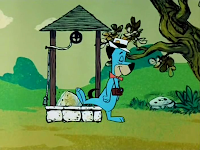
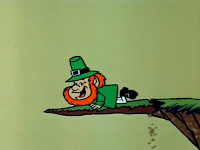
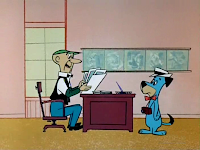








































.png)
.png)
.png)
.png)
.png)
.png)
.png)

































